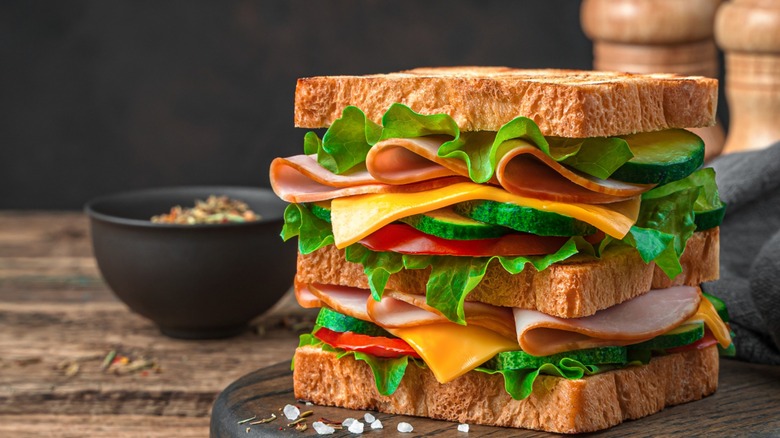Adding Acidic Ingredients Will Do Your Sandwiches A Favor
Making the perfect sandwich is an art unto itself. It's no wonder there's such a wide range of quality. From the basic ham and cheese workhorse to those stacked-up monsters only Dagwood could wrestle into his mouth, it's all a balancing act. Those who get it just right are rewarded with a masterpiece. Those who don't are doomed to the mundane. It's more than walking the line between too much or too little bread, the ideal meat-to-cheese ratio, or tapping the right combination of produce and condiments. There's also that key often overlooked ingredient — acidity.
The true art of making a sandwich (or any dish, really) is actually a science of flavor balance using the five flavors: sweet, salt, bitter, sour, and umami. For example, in a classic Italian sub, cured meats like ham, mortadella, salami, and prosciutto provide both umami and salt, mustard provides bitterness, and ripe, sliced tomatoes bring the sweetness. And while that sandwich would still be tasty — it's the little sprinkle of red wine vinegar that really brings it all together. (Not to mention the pickled pepperoncini.)
Not only do acidic ingredients act as palate cleansers, breaking up the monotony of all that meat and bread, but their bright acidic zip and sometimes spicy kick lend a puckery pizzazz to any wayward sammie, activating your salivary glands, and keep your sandwich exciting to the very last bite.
How to raise the bar on your sandwiches with acidic ingredients
There's more to this acidity stuff than just red wine vinegar, though. Beyond the varieties of vinegar, there are also pickled and fermented ingredients like peppers, sauerkraut, and vegetables like spicy giardiniera (a blend of pickled cauliflower, carrots, and peppers) to help take your sandwich from bland to bussin' in no time.
Sandwiches rich in fats (meats and/or cheeses) also benefit greatly from acidity. Remember that basic ham and cheese? You can elevate it by grilling the bread and adding a thick slice of roasted pork. But to cut through the heaviness and make this sandwich unforgettable, you'll need to hit it with vibrantly zingy slices of dill pickle. How about luscious pâté-laden bánh mì? Would it be as satisfying without the sweet-tart flavor of chili-pickled carrots, cucumbers, and daikon radish providing spice, crunch, and plenty of juicy tang to counter the unctuous richness of grilled meat and pungently earthy pâté?
Of course, these examples are more labor-intensive, but that doesn't mean you can't apply the same principles in your day-to-day creations. Try tuning-up bland tuna with a squeeze of fresh lemon juice, inserting a few slices of tart green apple in grilled cheese, or pickled red onions on deli-sliced roast beef. Now, that you understand the importance acidic ingredients play in cultivating flavor that's not only balanced, but extraordinary, you can begin experimenting with your favorite ingredients and see how they stack up.

